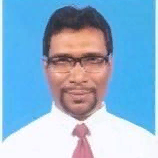
Md. Imdadul Islam
Work place: Department of Computer Science and Engineering, Jahangirnagar University, Dhaka, Bangladesh
E-mail: sairoelamertet23@gmail.com
Website: https://orcid.org/0000-0003-2045-6382
Research Interests: Network Engineering, Programming Language Theory, Information Theory, , Wireless Networks, Computational Learning Theory, Neural Networks, Network Architecture, Network Security
Biography
Md. Imdadul Islam has completed his B.Sc. Engineering in Electrical and Electronic Engineering from Bangladesh University of Engineering and Technology, Dhaka in 1993 and M.Sc Engineering from the same university in 1998. He has completed CAS program from Asian Institute of Technology, Thailand in 2001. He has done Ph.D. at the department of Computer Science and Engineering, J.U., Dhaka, in the field of Network Traffic. He worked as an Assistant Engineer in Sheba Telecom (Pvt.) LTD (A joint venture company between Bangladesh and Malaysia) from Sept'94 to July'96. He has very good field experiences in installation of Radio Base Station and Switching Center for WLL. He is now working as a Professor, at the department of Computer Science and Engineering, Jahangirnagar University, Savar, Dhaka, Bangladesh. His research field is network traffic, wireless communications, wavelet transform, OFDMA, adaptive filter theory, neural network and machine learning. He has more than two hundred research papers in national and international journals and conference proceedings.
Author Articles
The Performance Analysis of Digital Filters and ANN in De-noising of Speech and Biomedical Signal
By Humayra Ferdous Sarwar Jahan Fahima Tabassum Md. Imdadul Islam
DOI: https://doi.org/10.5815/ijigsp.2023.01.06, Pub. Date: 8 Feb. 2023
A huge number of algorithms are found in recent literature to de-noise a signal or enhancement of signal. In this paper we use: static filters, digital adaptive filters, discrete wavelet transform (DWT), backpropagation, Hopfield neural network (NN) and convolutional neural network (CNN) to de-noise both speech and biomedical signals. The relative performance of ten de-noising methods of the paper is measured using signal to noise ratio (SNR) in dB shown in tabular form. The objective of this paper is to select the best algorithm in de-noising of speech and biomedical signals separately. In this paper we experimentally found that, the backpropagation NN is the best for de-noising of biomedical signal and CNN is found as the best for de-noising of speech signal, where the processing time of CNN is found three times higher than that of backpropagation.
[...] Read more.Image Recognition Using Machine Learning with the Aid of MLR
By Meherunnesa Tania Diba Afroze Jesmin Akhter Abu Sayed Md. Mostafizur Rahaman Md. Imdadul Islam
DOI: https://doi.org/10.5815/ijigsp.2021.06.02, Pub. Date: 8 Dec. 2021
In this paper, we use three machine learning techniques: Linear Discriminant Analysis (LDA) along different Eigen vectors of an image, Fuzzy Inference System (FIS) and Fuzzy c-mean clustering (FCM) to recognize objects and human face. Again, Fuzzy c-mean clustering is combined with multiple linear regression (MLR) to reduce the four-dimensional variable into two dimensional variables to get the influence of all variables on the scatterplot. To keep the outlier within narrow range, the MLR is again applied in logistic regression. Individual method is found suitable for particular type of object recognition but does not reveal standard range of recognition for all types of objects. For example, LDA along Eigen vector provides high accuracy of detection for human face recognition but very poor performance is found against discrete objects like chair, butterfly etc. The FCM and FIS are found to provide moderate result in all kinds of object detection but combination of three methods of the paper provide expected result with low process time compared to deep leaning neural network.
[...] Read more.Other Articles
Subscribe to receive issue release notifications and newsletters from MECS Press journals